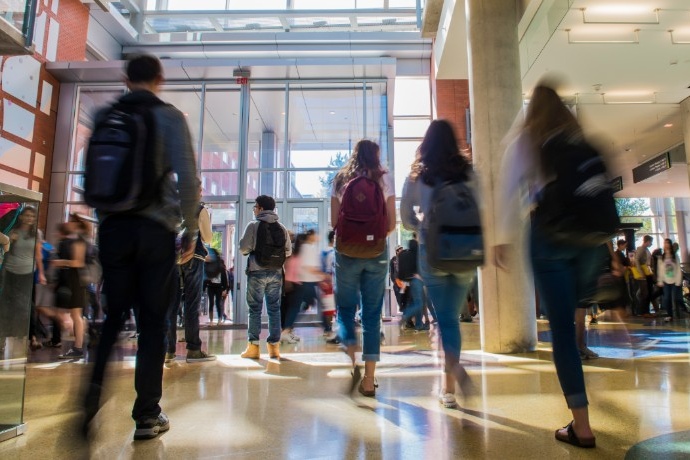
Nine female UAlberta undergraduate students attended the Canadian Conference for Undergraduate Women in Physics earlier this year. Photo credit: John Ulan
For Valerie Willier, being amongst peers who looked, spoke, and felt the same way she did was not only a first, it was also incredibly powerful.
An undergraduate student in the University of Alberta’s Department of Physics, Willier was one of nine female undergraduate students who attended the Canadian Conference for Undergraduate Women in Physics (CCUWiP) earlier this year.
“As someone who often struggles with feelings of loneliness within physics, the friends I made at this conference made me feel like I was a part of a hidden community that was waiting for me all along,” said Willier. “Hearing their stories, experiences, struggles, and triumphs was my greatest gift as a delegate. I have never felt more comfortable being in physics.”
Diversity in fields of science, technology, engineering, and mathematics (STEM) is an ongoing issue, and a complicated one at that. Improving diversity means better science through new perspectives, insights, and innovation permeating the work done in the classroom, laboratory, and field. While the Faculty of Science is proud to have achieved gender parity in our undergraduate student population, there are fewer women and other visible minorities as scientists move through the pipeline, from graduate students to postdoctoral fellows to faculty members, where 22 per cent are female. The numbers are even lower in physics.
“Within physics, it can be extremely challenging to feel like you belong in the field when you don’t see many role models that look like you, sound like you, talk like you, or know what it’s like to be from a background similar to yours,” explained Willier.
“As a person from a minority group, representation is important to me because it allows me to be confident in myself and my ability to succeed within STEM as I am—something I have never felt before coming to CCUWiP. Ultimately, to me, representation is important because it makes me feel like I deserve that seat in that lab or lecture theatre.”
A hidden community
Lindsay LeBlanc, assistant professor of physics and Canada Research Chair in Ultracold Gases for Quantum Simulation, is a proud champion of diversity and was instrumental in securing the funding that allowed the nine students to attend this year’s conference.
“Participating in events like this one, even just once, can change the path a student takes, and can help them imagine that there is more out there for them than they previously thought,” said LeBlanc. “If we, as senior members of the community, can show our support through sponsoring these events and sponsoring the students who attend them, we validate their experience and demonstrate our commitment to improving diversity in our field.”
Hosted at the University of Toronto in January 2020, this year’s CCUWiP included networking events, research talks, career panels, student presentations, and workshops on topics ranging from applying to graduate school to combating discrimination.
“By working together and creating comfortable, safe spaces, female scientists encounter great advancements in their field as well as their personal development by conducting science in a place that allows them to reach their full potential,” added Willier.
Interested in learning more about the state of diversity in the Faculty of Science? Read our most recent diversity report, or visit our diversity hub.
In February 2019, UAlberta launched its Equity, Diversity and Inclusivity (EDI) Strategic Plan. The plan sets out institutional priorities and goals over the next four years, with special emphasis in the first year on establishing improved systems for data collection (both quantitative and qualitative) to support target setting and identify specific barriers, on developing resources to integrate EDI considerations into research and teaching, and on sustaining and enhancing training and development across the university.